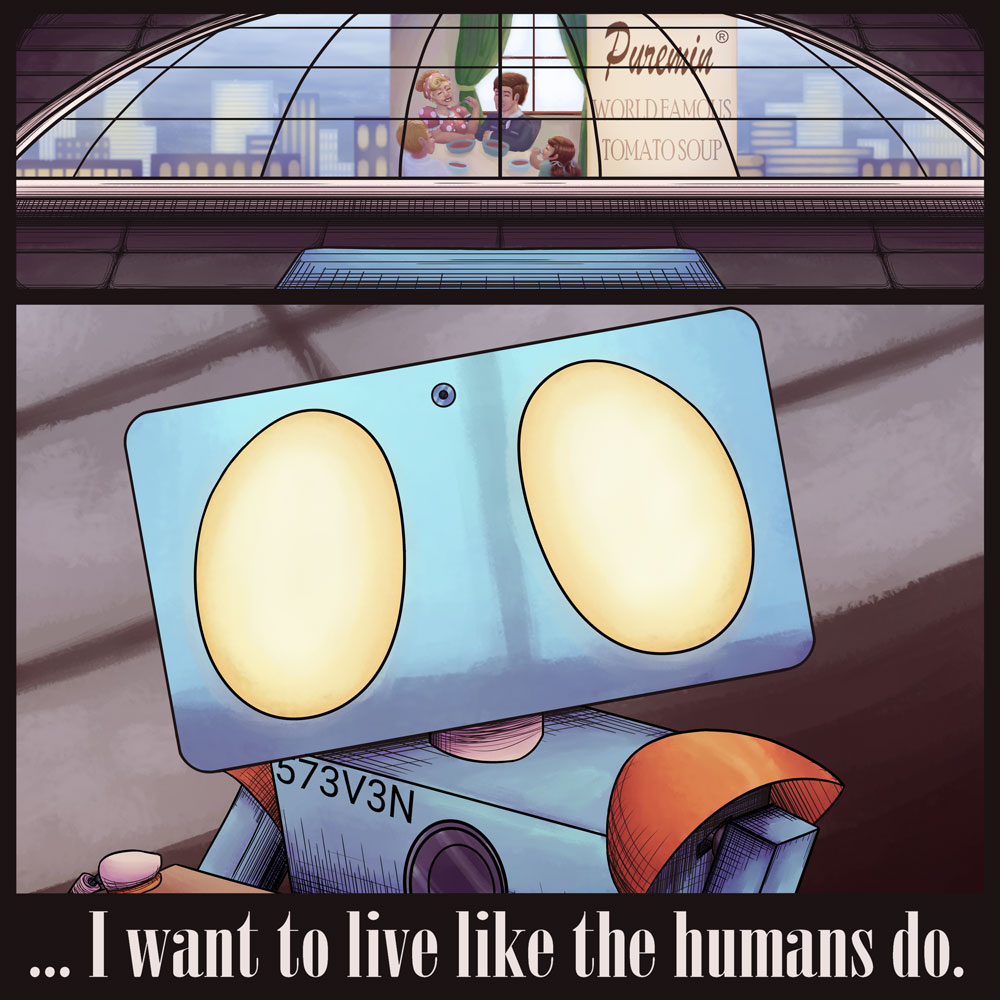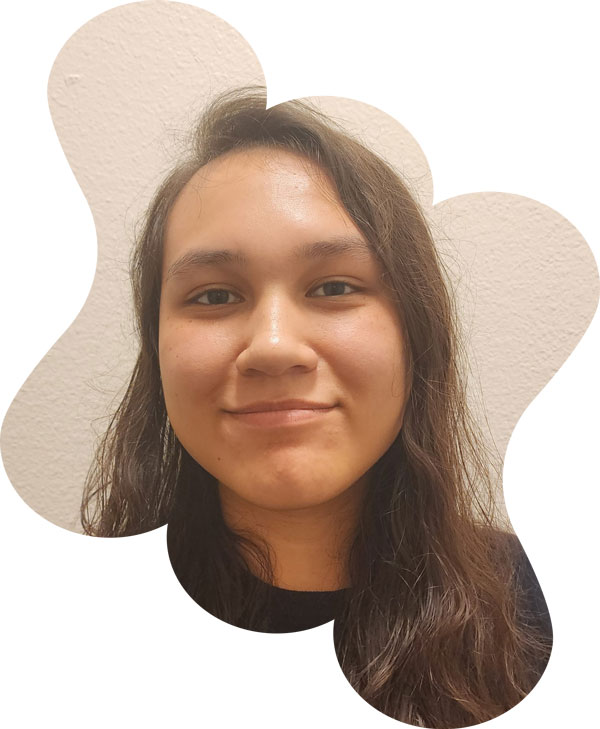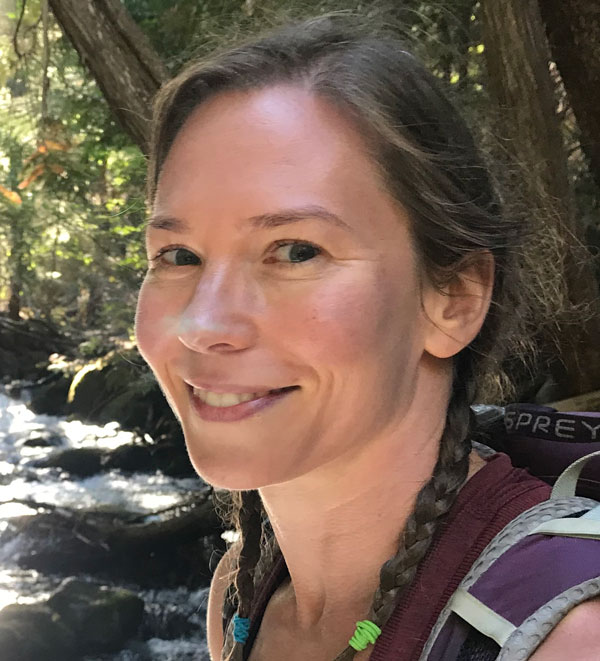

Human

Height: 31.2” x Width: 31.2” | Idea(s): A robot designed to be a factory slave gains the desire to live a comfortable life the way humans do | Material(s): FireAlpaca, Wacom Intuos Pro, pen brush & realistic watercolor brush (FireAlpaca) | Process(es): Experimentation in character design, block in composition, linework, base colors, paint, details | Curatorial Note: An interesting investigation of artificial intelligence. The student uses AI as a subject rather than a tool to create art.
Angela Winn


Student statement
Student statement
Please describe the context for how the idea for this artwork originated (was this part of your sustained investigation, an independent project, a class assignment, created during a summer study, etc.).
Ever since the world was first blown away by ChatGPT, I've been fascinated with AI. It felt like we've finally stepped into the age various sci-fi authors have written about. With my newfound passion for the field and my interest in computer science, I now dream of becoming an AI researcher. However, I don’t want to turn blindly optimistic. I need to keep ethical considerations in mind as I get into the development of tech, which leaves us with such an uncertain, hazy future. I wanted to express my concerns and ideas through my creative endeavors, which led to artificial intelligence becoming a core part of my sustained investigation. One of the most pressing concerns for me is machine sentience. Ilya Sutskever, OpenAI’s former chief scientist, claims that today’s large language models may be conscious. The Turing test has become obsolete, yet the public still treats the thought of machine life as an impossibility. We’ve already developed algorithms capable of certain kinds of reasoning. Even if we believe the models of today are certainly nothing but cold calculators, when will we begin to question their potential for sentience? Will we end up creating a slave race out of our unwillingness to consider it?
In my creative writing class, I explored the notion with a short story. I wrote about the change of heart a technician had, which led to him saving the robot 573V3N (or Steven) shown in this piece. I like to add art pieces to my fictional writings as I believe they help set the tone, mood, and visuals of the setting. Inversely, I also like to imply worlds or stories within the pictures I draw to help guide the viewer’s imagination. Since my AP 2D Art and Design portfolio revolves around AI, I thought I could kill two birds with one stone by making a piece designed for both my portfolio and my story. One scene within the story I felt could work well for a stand-alone image is the inciting event: Steven’s newfound desires.
In what ways did you practice and experiment when developing your sustained investigation?
Each piece within my investigation had one consistent theme: They were all drawings that conveyed alternate worlds from ours, depicting possible scenarios all centered around what the development of AI could hold. Originally, within my first piece, I had drawn something that is grounded in a style quite similar to what I normally draw. However, I realized that the same style couldn’t work for every setting. For each image to capture the proper emotion, tone, and setting the scene is set in, I needed to give each piece its own style.
The first thing I played around with was the brushes used. As a digital artist, the tools and materials available to me felt simultaneously constrained yet limitless. I can’t go in and dab a paper towel onto my piece; I had to render the textures myself. At the same time, there’s a digital representation for almost anything. Crayons, watercolor, and markers are all available for free within the art program I use. So, the first step of the process was to explore what I could do with what was accessible to me. Next, I needed to figure out the style. While I’m still conceptualizing my pieces, I often have a vague idea in mind of what it’s going to look like already. This is where I turn that vague idea into something malleable and real. I make some alterations to the style based on what the scene needs. How exaggerated are the proportions going to be, and what will end up exaggerated? What is the color scheme? Which brushes can achieve which textures together, and what can I use them for? At this stage, I’m focused on trying to capture the vibe the scene is meant to encapsulate. In the last step before I begin on the project, I work on how exactly I’m going to convey the concept I had in mind. Just like with the style, I often already have a vague image in my head, but my first idea is not necessarily the best way to represent the concept. Here, I work on the composition of what is framed as well as the design of both the character(s) and the environment around them. Ultimately, this resulted in each world feeling uniquely their own.
The feeling encapsulated in each piece was achieved by varying processes, as not everything can be achieved through the same methods. For example, this piece required lines to differentiate between foreground and background as well as a way to apply shadow, while another piece lacked linework entirely. Every concept needs something different, so blanketing the representation of all your ideas under the same style restricts what you can do and how well you can get the message across.

My artworks serve as warnings as to what could go wrong or as a heads-up as to what could happen as technology progresses.
How did you demonstrate revision in your sustained investigation?
When making my pieces, I rarely make something perfect on the first try. Before I go in and work on what will be the final image, I experiment with different aspects of it. I take note of what I do and don’t like—usually mentally, but in the case of my AP work I write down my thoughts—then alter what I do have until I’m satisfied. Sometimes, this means something small like altering the character’s color scheme, as I did with this piece. Other times, this means something more drastic like scratching the idea entirely and trying out something else. Even once I start working on the project, I have to make changes here and there. I think the most important thing to keep in mind during the process is to try not to get too attached to the first version I have.
How did your art teacher support your artistic development?
Ms. Pearson pushed me to go beyond my comfort zone. When I’m unhappy with any aspect of my current piece, she’s always there to help me figure out what went wrong. She’s happy to be a soundboard for any ideas I may have. She strikes that perfect balance between providing helpful criticisms and providing me with enough encouragement to feel proud. With every class, she brings a cheerful, playful, and friendly demeanor, which always manages to brighten her students’ day. How she manages to be so supportive to each pupil astounds me. She’s a talented, creative, cheerful, and kind individual. I feel grateful to have had her for all four years of my high school experience. My art journey would not have been the same without her.
What is your advice to other AP Art and Design students?
I think lots of students forget that their portfolio does not only showcase their skill, but also their thoughts and ideas. What AP checks is not just whether you can make a pretty picture. They want to see your reason, your “why” behind art. Before you even start your portfolio, you need to search for something you’re deeply passionate about. Try to find something you can talk about endlessly, then incorporate that into every piece you make. Show your love for the topic and keep that thread consistent within your portfolio. Know that by this, I don’t mean you must create something profound or thought-provoking. Not everyone has to be Plato. Your passion could be derived from many things. Can’t stop thinking about your D&D campaigns? Show what happens in them. Do you find yourself stuck in the past, reflecting back on your unique personal experiences? Create your visual autobiography. Do you just really like a certain topic and wish to convey your thoughts on it? Then draw a bunch of robots! That's what I did, at least. Whatever it is you obsess over, make something that shows your genuine interest in it.

Marie Pearson
Art Teacher
Ida B. Wells High School, Portland, OR, USA
Teacher statement
Teacher statement
How did you structure practice, experimentation, and revision into your AP Art and Design curriculum?
Angela was a student in my art classes during all four years of her high school career. She developed her concepts, practiced, and experimented in her sketchbook and on her computer. Angela excels at asking for advice, and she tests out a variety of suggestions before deciding which conveys her idea best. For her artwork of AI robot 573V3N, Angela uses color, lighting, text, and composition to evoke an emotional response.
How do you support your students in the Selected Works portfolio component?
In April, students select their strongest 5 to10 artworks and bring them to class. I structure a peer critique where AP students give recommendations and reasons for their choices. Then I meet with students individually to review their selection.
What formative and summative assessments helped guide your students through your AP Art and Design curriculum?
The most helpful formative assessments have been one-on-one conversations, small group peer critiques, and anonymous written feedback. Quarterly wall critiques and semester presentations have been our most important and supportive summative assessments.
What did you learn from working with your student?
In addition to being a highly skilled and creative artist, Angela is a wonderful person. She is genuine, persistent, and always has an attitude of gratitude. I learned more about digital tools from watching Angela work, and I learned more about AI.

Angela Winn

